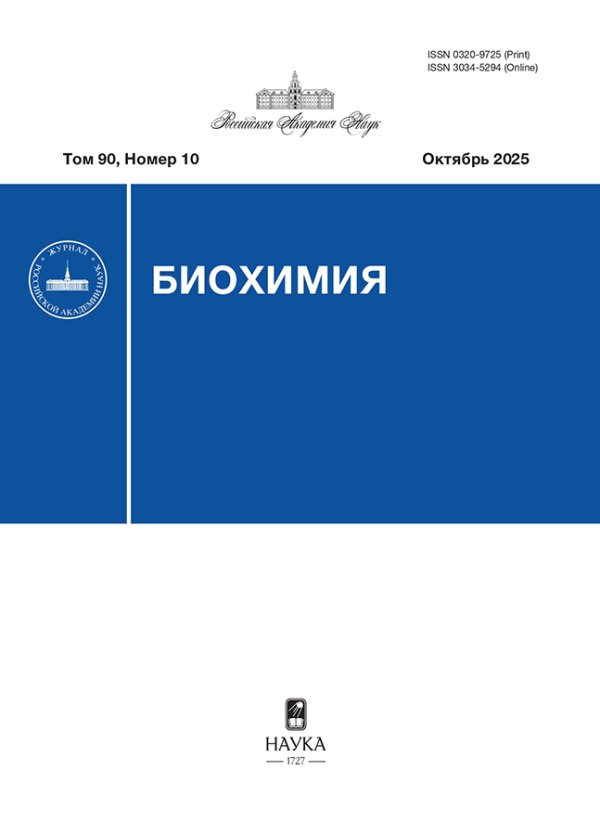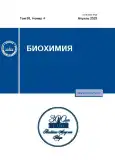Acute and chronic lipopolysaccharide-induced stress changes expression of proinflammatory cytokine genes in the rat brain region-specifically and affects learning and memory
- Authors: Zaichenko M.I1, Philenko P.1, Sidorina V.1, Grigoryan G.A1
-
Affiliations:
- Institute of Higher Nervous Activity and Neurophysiology, Russian Academy of Sciences
- Issue: Vol 88, No 4 (2023)
- Pages: 642-655
- Section: Articles
- URL: https://journals.rcsi.science/0320-9725/article/view/144664
- DOI: https://doi.org/10.31857/S0320972523040085
- EDN: https://elibrary.ru/AKUTQU
- ID: 144664
Cite item
Full Text
Abstract
About the authors
M. I Zaichenko
Institute of Higher Nervous Activity and Neurophysiology, Russian Academy of Sciences
Email: mariya-zajchenko@yandex.ru
117485 Moscow, Russia
P. Philenko
Institute of Higher Nervous Activity and Neurophysiology, Russian Academy of Sciences
Email: mariya-zajchenko@yandex.ru
117485 Moscow, Russia
V. Sidorina
Institute of Higher Nervous Activity and Neurophysiology, Russian Academy of Sciences
Email: mariya-zajchenko@yandex.ru
117485 Moscow, Russia
G. A Grigoryan
Institute of Higher Nervous Activity and Neurophysiology, Russian Academy of Sciences
Email: mariya-zajchenko@yandex.ru
117485 Moscow, Russia
References
- Alexander, C., and Rietschel, E. T. (2001) Bacterial lipopolysaccharides and innate immunity, J. Endotoxin. Res., 7, 167-202, doi: 10.1177/09680519010070030101.
- Груздева В. А., Шаркова А. В., Зайченко M. И., Григорьян Г. А. (2021) Влияние раннего провоспалительного стресса на проявление импульсивного поведения у крыс разного возраста и пола, Журн. высш. нервн. деят., 71, 114-125, doi: 10.31857/S0044467721010056.
- Kupferschmid, B. J., and Therrien, B. A. (2018) Spatial learning responses to lipopolysaccharide in adult and aged rats, Biol. Res. Nurs., 20, 32-39, doi: 10.1177/1099800417726875.
- Зайченко М. И., Шаркова А. В., Павлова И. В., Григорьян Г. А. (2022) Половые различия во влияниях раннего провоспалительного стресса на обучение и память взрослых крыс в водном лабиринте Морриса, Журн. высш. нервн. деят., 72, 233-249, doi: 10.31857/S0044467722020125.
- Stepanichev, M. Y., Goryakina, T., Manolova, A., Lazareva, N., Kvichanskii, A., Tretyakova, L., Volobueva, M., and Gulyaeva, N. (2021) Neonatal proinflammatory challenge evokes a microglial response and affects the ratio between subtypes of GABAergic interneurons in the hippocampus of juvenile rats: sex-dependent and sex-independent effects, Brain Struct. Funct., 226, 563-574, doi: 10.1007/s00429-020-02199-z.
- Григорьян Г. А. (2020) Половые различия в поведении и биохимических маркерах у животных в ответ на нейровоспалительный стресс, Усп. физиол. наук, 51, 18-32, doi: 10.31857/S0301179820010051.
- Alzahrani, N. A., Bahaidrah, K. A., Mansouri, R. A., Alsufiani, H. M., and Alghamdi, B. S. (2022) Investigation of the optimal dose for experimental lipopolysaccharide-induced recognition memory impairment: behavioral and histological studies, J. Integr. Neurosci., 21, 49, doi: 10.31083/j.jin2102049.
- Arai, K., Matsuki, N., Ikegaya, Y., and Nishiyama, N. (2001) Deterioration of spatial learning performances in lipopolysaccharide-treated mice, Jpn. J. Pharmacol., 87, 195-201, doi: 10.1254/jjp.87.195.
- Couch, Y., Trofimov, A., Markova, N., Nikolenko, V., Steinbusch, H. W., Chekhonin, V., et al. (2016) Low-dose lipopolysaccharide (LPS) inhibits aggressive and augments depressive behaviours in a chronic mild stress model in mice, J. Neuroinflammation, 13, 108, doi: 10.1186/s12974-016-0572-0.
- Dang, R., Guo, Y. Y., Zhang, K., Jiang, P., and Zhao, M. G. (2019) Predictable chronic mild stress promotes recovery from LPS-induced depression, Mol. Brain, 12, 42, doi: 10.1186/s13041-019-0463-2.
- Shaw, K. N., Commins, S., and O'Mara, S. M. (2001) Lipopolysaccharide causes deficits in spatial learning in the water maze but not in BDNF expression in the rat dentate gyrus, Behav. Brain Res., 124, 47-54, doi: 10.1016/s0166-4328(01)00232-7.
- Sparkman, N. L., Martin, L. A., Calvert, W. S., and Boehm, G. W. (2005) Effects of intraperitoneal lipopolysaccharide on Morris maze performance in year-old and 2-month-old female C57BL/6J mice, Behav. Brain Res., 159, 145-151, doi: 10.1016/j.bbr.2004.10.011.
- Kupferschmid, B. J., Rowsey, P. J., and Riviera, M. (2020) Characterization of spatial learning and sickness responses in aging rats following recurrent lipopolysaccharide administration, Biol. Res. Nurs., 22, 92-102, doi: 10.1177/1099800419875824.
- Kahn, M. S., Kranjac, D., Alonzo, C. A., Haase, J. H., Cedillos, R. O., McLinden, K. A., Boehm, G. W., and Chumley, M. J. (2012) Prolonged elevation in hippocampal Aβ and cognitive deficits following repeated endotoxin exposure in the mouse, Behav. Brain Res., 229, 176-184, doi: 10.1016/j.bbr.2012.01.010.
- Xin, Y. R., Jiang, J. X., Hu, Y., Pan, J. P., Mi, X. N., Gao, Q., Xiao, F., Zhang, W., and Luo, H. M. (2019) The Immune system drives synapse loss during lipopolysaccharide-induced learning and memory impairment in mice, Front. Aging Neurosci., 11, 279, doi: 10.3389/fnagi.2019.00279.
- Barter, J., Kumar, A., Rani, A., Colon-Perez, L. M., Febo, M., and Foster, T. C. (2020) Differential effect of repeated lipopolysaccharide treatment and aging on hippocampal function and biomarkers of hippocampal senescence, Mol. Neurobiol., 57, 4045-4059, doi: 10.1007/s12035-020-02008-y.
- Arab, Z., Hosseini, M., Marefati, N., Beheshti, F., Anaeigoudari, A., Sadeghnia, H. R., and Boskabady, M. H. (2022) Neuroprotective and memory enhancing effects of Zataria multiflora in lipopolysaccharide-treated rats, Vet. Res. Forum, 13, 101-110, doi: 10.30466/vrf.2020.117553.2786.
- Keymoradzadeh, A., Hedayati, Ch. M., Abedinzade, M., Gazor, R., Rostampour, M., and Taleghani, B. K. (2020) Enriched environment effect on lipopolysaccharide-induced spatial learning, memory impairment and hippocampal inflammatory cytokine levels in male rats, Behav. Brain Res., 394, 112814, doi: 10.1016/j.bbr.2020.112814.
- Jin, Y., Peng, J., Wang, X., Zhang, D., and Wang, T. (2017) Ameliorative effect of ginsenoside rg1 on lipopolysaccharide-induced cognitive impairment: role of cholinergic system, Neurochem. Res., 42, 1299-1307, doi: 10.1007/s11064-016-2171-y.
- Sohroforouzani, A. M., Shakerian, S., Ghanbarzadeh, M., and Alaei, H. (2020) Treadmill exercise improves LPS-induced memory impairments via endocannabinoid receptors and cyclooxygenase enzymes, Brain Res., 380, 112440, doi: 10.1016/j.bbr.2019.112440.
- Grigoryan, G. A., Mitchell, S. N., Hodges, H., Sinden, J. D., and Gray, J. A. (1994) Are the cognitive-enhancing effects of nicotine in the rat with lesions to the forebrain cholinergic projection system mediated by an interaction with the noradrenergic system? Pharmacol. Biochem. Behav., 49, 511-521, doi: 10.1016/0091-3057(94)90063-9.
- Shanks, N., Larocque, S., and Meaney, M. J. (1995) Neonatal endotoxin exposure alters the development of the hypothalamic-pituitary-adrenal axis: early illness and later responsivity to stress, J. Neurosci., 15, 376-384, doi: 10.1523/JNEUROSCI.15-01-00376.1995.
- Shanks, N., Windle, R. J., Perks, P. A., Harbuz, M. S., Jessop, D. S., Ingram, C. D., and Lightman, S. L. (2000) Early-life exposure to endotoxin alters hypothalamic-pituitary-adrenal function and predisposition to inflammation, Proc. Natl. Acad. Sci. USA, 97, 5645-5650, doi: 10.1073/pnas.090571897.
- Paxinos, G., and Watson, C. (2007) The Rat Brain in Stereotaxic Coordinates, Academic Press, 6th Edn, San Diego.
- Dobryakova, Y. V., Kasianov, A., Zaichenko, M. I., Stepanichev, M. Y., Chesnokova, E. A., Kolosov, P. M., Markevich, V. A., and Bolshakov, A. P. (2018) Intracerebroventricular administration of 192IgG-saporin alters expression of microglia-associated genes in the dorsal but not ventral hippocampus, Front. Mol. Neurosci., 10, 429, doi: 10.3389/fnmol.2017.00429.
- Livak, K. J., and Schmittgen, T. D. (2001) Analysis of relative gene expression data using real-time quantitative PCR and the 2-ΔΔCT method, Methods, 25, 402-408, doi: 10.1006/meth.2001.1262.
- Mizobuchi, H., Yamamoto, K., Tsutsui, S., Yamashita, M., Nakata, Y., Inagawa, H., Kohchi, C., and Soma, G. I. (2020) A unique hybrid characteristic having both pro- and anti-inflammatory phenotype transformed by repetitive low-dose lipopolysaccharide in C8-B4 microglia, Sci. Rep., 10, 8945, doi: 10.1038/s41598-020-65998-8.
- Hauss-Wegrzyniak, B., Vraniak, P. D., and Wenk, G. L. (2000) LPS-induced neuroinflammatory effects do not recover with time, Neuroreport, 11, 1759-1763, doi: 10.1097/00001756-200006050-00032.
- Tanaka, S., Ide, M., Shibutani, T., Ohtaki, H., Numazawa, S., Shioda, S., and Yoshida, T. (2006) Lipopolysaccharide-induced microglial activation induces learning and memory deficits without neuronal cell death in rats, J. Neurosci. Res., 83, 557-566, doi: 10.1002/jnr.20752.
- Huang, Z. B., Wang, H., Rao, X. R., Liang, T., Xu, J., Cai, X. S., and Sheng, G. Q. (2010) Effects of immune activation on the retrieval of spatial memory, Neurosci, Bull., 26, 355-364, doi: 10.1007/s12264-010-0622-z.
- Grigoryan, G. A., Weiss, I., and Feldon, I. (2010) Social isolation improves working memory at reversal but not primaty radial-arm learning in rats, Zhurn. Vysch. Nervn. Deyat., 60, 560-567.
- Cunningham, C., and Sanderson, D. J. (2008) Malaise in the water maze: untangling the effects of LPS and IL-1beta on learning and memory, Brain Behav. Immun., 22, 1117-1127, doi: 10.1016/j.bbi.2008.05.007.
- Zhu, B., Wang, Z. G., Ding, J., Liu, N., Wang, D. M., Ding, L. C., and Yang, C. (2014) Chronic lipopolysaccharide exposure induces cognitive dysfunction without affecting BDNF expression in the rat hippocampus, Exp. Ther. Med., 7, 750-754, doi: 10.3892/etm.2014.1479.
- Sparkman, N. L., Buchanan, J. B., Heyen, J. R., Chen, J., Beverly, J. L., and Johnson, R. W. J. (2006) Interleukin-6 facilitates lipopolysaccharide-induced disruption in working memory and expression of other proinflammatory cytokines in hippocampal neuronal cell layers, Neuroscience, 26, 10709-10716, doi: 10.1523/JNEUROSCI.3376-06.2006.
- Lima Giacobbo, B., Doorduin, J., Klein, H. C., Dierckx, R. A. J. O., Bromberg, E., and de Vries, E. F. J. (2019) Brain-derived neurotrophic factor in brain disorders: focus on neuroinflammation, Mol. Neurobiol., 56, 3295-3312, doi: 10.1007/s12035-018-1283-6.
- Elkabes, S., Peng, L., and Black, I. B. (1998) Lipopolysaccharide differentially regulates microglial trk receptors and neurotrophin expression, J. Neurosci Res., 54, 117-122, doi: 10.1002/(SICI)1097-4547(19981001)54:1<117::AID-JNR12>3.0.CO;2-4.
- Miwa, T., Furukawa, S., Nakajima, K., Furukawa, Y., and Kohsaka, S. (1997) Lipopolysaccaride enhances synthesis of brain-derived neurotrophic factor in cultured rat microglia, J. Neurosci. Res., 50, 1023-1029, doi: 10.1002/(SICI)1097-4547(19971215)50:6<1023::AID-JNR13>3.0.CO;2-5.
- Zhao, J., Bi, W., Xiao, S., Lan, X., Cheng, X., Zhang, J., Lu, D., Wei, W., Wang, Y., Li, H., Fu, Y., and Zhu, L. (2019) Neuroinflammation induced by lipopolysaccharide causes cognitive impairment in mice, Sci. Rep., 9, 5790, doi: 10.1038/s41598-019-42286-8.
- Kamdi, S. P., Raval, A., and Nakhate, K. T. (2021) Phloridzin attenuates lipopolysaccharide-induced cognitive impairment via antioxidant, anti-inflammatory and neuromodulatory activities, Cytokine, 139, 155408, doi: 10.1016/j.cyto.2020.155408.
- Chowdhury, A. A., Gawali, N. B., Munshi, R., and Juvekar, A. R. (2018) Trigonelline insulates against oxidative stress, proinflammatory cytokines and restores BDNF levels in lipopolysaccharide induced cognitive impairment in adult mice, Metab. Brain Dis., 33, 681-691, doi: 10.1007/s11011-017-0147-5.
Supplementary files










